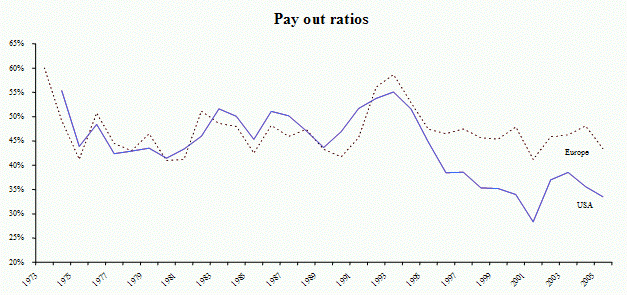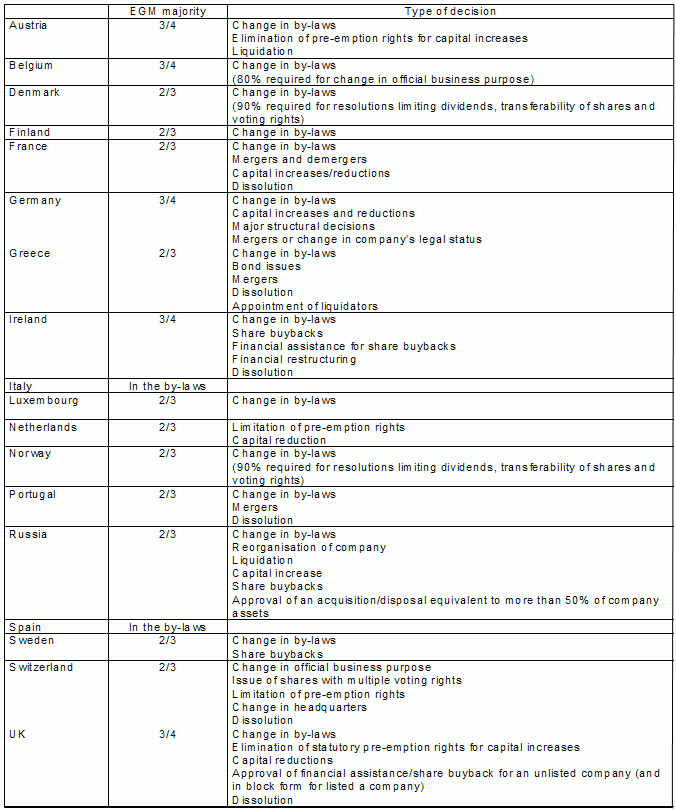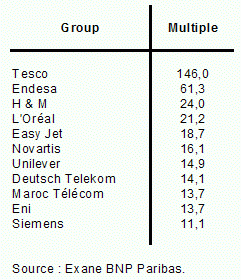Letter number 6 of May 2005
- TOPIC
- STATISTICS
- RESEARCH
- QUESTIONS & COMMENTS
News : What dividend to pay in 2005?
1 - Firstly, is it a good idea to have a dividend policy?
Yes it is, there's absolutely no doubt about that! When it comes to dividends, there is nothing worse than the lack of a clearly thought-out dividend policy. This leads to a situation in which dividend payments vary erratically from one year to the next, something investors find very unsettling. Similarly, policies that are simply not credible should also be avoided. Never promise to pay a dividend that would be excessive when compared with the cash generated by the company and investments needed. This would only prompt investors to ask when the dividend was going to be cut, which is never great for the share price, as Lloyds TSB has learnt to its cost since 2002.
2 - Why pay a dividend?
Firstly, because at the moment its what shareholders want and because dividends are back in fashion. Not that long ago (November 1998) Telefonica stopped paying a dividend, and its share price rose by 9%. These days, the same announcement would have the opposite effect, since it is clear that companies paying high dividends are valued by the market on the basis of higher multiples than those that aren’t (1).
It is also a means whereby shareholders can reduce management’s room for manoeuvre, by limiting the company’s ready cash. This is the sort of purgative that Molière’s Doctor Sganarelle could have prescribed! This lack of confidence of investors in the management of the companies of which they have chosen to become shareholders is, to say the least, regrettable. It is understandable in the light of some of the excessive behaviour witnessed in the late 1990s, the general deleveraging currently going on, and the high levels of cash flow currently being generated. This is an example of agency theory at work (2) .
Finally, paying a dividend is a reliable signal, and perceived as such on the company’s market over the next two to three years. It would be hard to imagine a responsible manager suggesting to increase the dividend per share, only to cut it the following year due to poor results or the need to restructure. In short, increasing the size of dividend payments is an expression of management’s confidence in the future, based on information accessible to management but not necessarily available in the public domain. This is an example of signalling theory at work (3).
3- How much?
In this area, cold financial logic should prevail. Once the target financial structure set by management and shareholders (in line with their risk propensity) has been achieved, the company must return to its shareholders every euro that is not invested in projects that, given their level of risk, are bringing in returns at least equal to the cost of capital.
There are three ways of returning cash to shareholders:
- Payment of an ordinary dividend, with serious thought given to any changes in the size of dividends from one year to the next. Like changing the direction of a super tanker, it’s something that should be done very gradually.
- Payment of an extraordinary dividend, which as its name indicates, is paid in extraordinary circumstances. Extraordinary dividends are not paid out on a recurring basis. They are used to give cash back to shareholders following the disposal of an activity which has filled the company’s coffers, Enel in 2004) or the accumulation of very good results over time (Bouygues in 2005).
- Share buybacks, with a lot of flexibility in the way they are carried out, even though they are strictly controlled by market regulators. Since share buybacks modify the number of shares, they obviously have an impact on EPS and the shareholders’ breakdown. They only make financial sense when share prices appear to be low.
Below is a table showing the rate of dividend payouts in France, Europe and the USA since 1973. Enjoy! (4).
(2) For more on agency theory, see chapter 32 of the Vernimmen.
(3) For more on signalling theory, see chapter 32 of the Vernimmen.
(4) A more detailed version is provided in chapter 38 of the Vernimmen.
Statistics : EGM across Europe
Interestingly, Spanish- and Italian-registered companies do not require a qualified majority and allow companies the choice of whether to include it in their by-laws.
Below a blocking minority, minority rights are limited in all countries. However, with between 5% (in Austria, France, Germany, Spain and Portugal) and 20% of the shares (in Belgium and Italy) a minority or group of minorities can call an EGM or add items to the agenda.
For more, see chapter 41 of the Vernimmen.
Research : What do entrepreneurs pay for VC affilation?
Academic researchers have looked long and hard at the issue of start-up financing from the point of view of venture capitalists. This group of investors has always been lumped together and considered as a homogenous whole. In the research, venture capitalists are assumed to be more efficient than other providers of funds, due to their greater ability to reduce information asymmetry between management and the investor, thanks, not only to their understanding of the sector, but also to the specific means of financing used. They are thus able to offer entrepreneurs better financial and contractual terms and conditions.
However, looking at it from the entrepreneur’s point of view, all venture capitalists are not cut from the same cloth. Founders of start-ups are well aware that the reputation of the venture capitalist who has provided the funds is just as important, if not more so, than the amount of cash raised. Is there any scientific basis for this proposition? If so, is it possible to measure the economic impact of affiliation with a reputable venture capital firm? David Hsu of the Wharton Business School looked at these issues in a recent article in the Journal of Finance(1).
What is it that makes one venture capitalist more attractive than another? A venture capitalist which has accumulated experience in an industrial sector and established a network of contacts, could provide the entrepreneur with a wide palette of high value-added services. Examples of such services include winning new customers, hiring key staff, formation of strategic alliances, acquisitions, raising more funds subsequently, and obtaining vital information for growing the company. Since the value of these services grows in line with the venture capitalist’s experience accumulation in a given sector, we can assume that there will be a correlation between the desire for venture capitalist affiliation and the venture capitalist’s experience accumulation in the sector.
Seeking to confirm these findings, Hsu examined two hypotheses. The first hypothesis is that financing offers from highly reputable venture capital firms are more likely to be accepted than those from less experienced players. The second hypothesis is that entrepreneurs will accept less money for an equal equity stake in their company, in order to secure the services of a more experienced venture capitalist. In other words, they agree to higher dilution in exchange for the services of a highly rated venture capital firm.
The study relied on data collected directly from the founders of 149 start-up firms in the initial development phase. Among the 149 firms polled, 51 received financing offers from several venture capitalists and a majority (57%) turned down the highest offer, which amounted to saying no to around $6m in average. This simple analysis of the results would appear to confirm Hsu’s second hypothesis.
The results also show that entrepreneurs accept a much larger discount on the valuation of their business and are probably more likely to accept a financing offer if:
- The venture capitalists have been involved in a large number of deals in their industry sector;
- The venture capitalists have more network resources to devote to them. These network resources are measured by the quality of contacts for recruiting staff, winning customers, securing suppliers and the services of investment banks. The entrepreneur accepting the financing places a value on these network resources.
It would thus appear that entrepreneurs are prepared to accept lower amounts of financing if the provider of funds has experience accumulation and would be able to help them in the subsequent development of the start-up.
Unfortunately, over and above this proposition and this intuitive interpretation, a precise definition cannot be given to exactly what economic goods entrepreneurs are buying along with this “experience” and “prestige”.
Q&A : What are EV / FCF Multiples?
Theoretically, since free cash flow is the cash that the company could pay out to its providers of funds, shareholders and lenders, after having financed its investments, this ratio should be a better indicator than P/E, which is more easily manipulated due to the accounting nature of the denominator.
However, such a conclusion would be overlooking the fact that EV/FCF is of little significance for companies in a high growth phase (whether external or internal growth), and accordingly have low or negative cash flow. An example of such a company is the mass retailer Tesco.
At 146 times, the figure doesn’t mean much, except perhaps that investors are expecting current investments to bear fruit in the future, and that the return ratio will fall within the average.
In other words, this ratio is more relevant for groups that have reached maturity, and that make large investments of generally similar amounts, resulting in high free cash flow.
Accordingly, we should not be surprised at the popularity of this ratio, nor of that of its opposite – free cash flow yield – evidence of an era in which there is little expectation of growth, and so not much chance of finding any!



